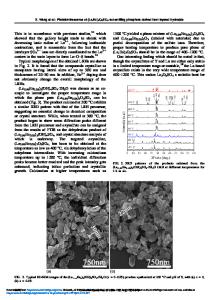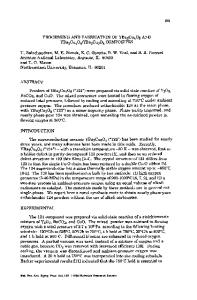Thermodynamic stability of Cu 2 SO 4
- PDF / 217,476 Bytes
- 2 Pages / 613 x 788.28 pts Page_size
- 37 Downloads / 338 Views
=
03/
25,104 - 11.1"/T j / m o l oot
GCr - GCr = 18,225 - 7 9
[2]
j/mol
Table I. The Calculated Equilibrium Constants (K) of Reactions Determining the Predominant Zones for Cu-:;-O System Including Cu2S04
log K Reaction 1. CuS + 2 O2 = CuSO4 2. 2 CuS + O2 = Cu2 S + SO= 3. Cu2S + SO2 + 3 O2 = 2 CuSO4 4. Cu2S + 3/2 O2 = Cu20 + SO2 5. Cu2S + O2 =2 Cu+ SO2 6.2 Cu20 = 4 Cu + O2 7.2 CuSO4 = Cu20 + 2 SO2 + 3/2 O2 8. CuO'CuSO4 = Cu20 + SO~ + O2 9. 2 CuSO4 = CuO-CuSO, + SOs + 1/2 02 10.4CuO = 2 Cu20 + O2 11. CuO'CuSO4 = 2 CuO + SO2 § 1[2 O2 12. Cu2 S + 2 O2 = Cu2 SO,• 13. Cu20 + SO~ + 1/2 O2 = Cu2SO,, 14. Cu2SO4 + SOz + Oz = 2 CuSO4
300~
350~
400~
46.57 27.76 65.38 30.14 18.77 -22.74 -35.23 -21.66 -13.58 -14.66 -14.33 42.47 12.33 22.91
41.39 25.77 57.01 27.28 17.12 -20.32 -29.73 -18.39 - t 1.34 -12.62 -12.08 37.54 10.26 19.47
36_98 24.07 49.89 24.83 15.70 -18.27 - 25.05 -15.62 - 9.44 -10.88 -10.18 33.34 8_50 16.55
[12]
These equations and the observed ideallty of the fcc solution are sufficient for describing the system. This study was supported by the Army Research Office, Durham and by the American Iron and Steel Institute.
,
,
I
,it
1
,
,
,
I
,
,
1. G. Kirchner, T. Nishizawa,and B. Uhrenius: Met. Trans., 1973, vol. 4, p. 167. 2. F. Miiller and O. Kubaschewski:High Temp.-High Pressure, 1969, vol. 1, p. 543. 3. W. A. Dench: Trans. FaradaySoc., 1963, vol. 59, pp. 127%92. 4. R. L. O{r and J. Chipman: Trans. TMS-AIME, 1967, vol. 239, p. 630. 5. L. Kaufman: In Phase Stability in MetalsandAlloys, P. S. Rudman, J. Stringer, and R. I. Jaffa, ads., McGraw-Hill,New York, 1967. 6. Y. Jeannin, C. Mannerskrantz,and F. D. Richardson: Trans. TMS-AIME, 1963, vol. 227, p. 300. 7. L. S. Darken and R. W. Gurry: Physical Chemistry of Metals, p. 276, McGrawHill Book Co., New York, 1953.
I
~o CuO~'~'~'~ I
I
I
I
I
I
-20
Manuscript submitted October 8 1973. METALLURGICAL TRANSACTIONS
I
I |
I
I
I
-15
Thermodynamic Stability of Cu2S04
M. NAGAMORI is a Member of the Research Staff, Materials Section, Centre de Recherche Industrielle du Quebec, Complexe Scientifique, Ste-Foy. F. HABASHI is Professor, Department of Mining and Metallurgy, Laval University, Ste-Foy, Quebec 10, P. Q., Canada.
I
(.9 0
,
The formation of Cu=SO4 phase was observed during hydrogen-reduction of CuSO41 and subsequently the crystalline characteristics of Cu2SO4 were established. 3 As for thermodynamic stability of various phases in the Cu-S-O system, several versions of the predominance diagram have been published. T M However, these equilibrium studies have failed to indicate the Cu~SO4 phase stability range. This note presents a new predominance diagram for the Cu-S-O system including the stability zone for Cu=SO4. The heat of formation (AH~sa) for Cu~SO4 (s) has been reported to be - 179.2 i 2.5 kcal/mole; s the corresponding entropy data (S;98) is still missing from the literature 9 Latimer's method 7 for calculating the entropy of solid ionic compounds has been proved to be an acceptable way to estimate some unknown values 9
Data Loading...










